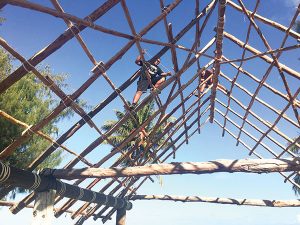DCCA program to complement 500 Sails

Seafaring Traditions Program’s John Castro, Oliver Salas, and Jonathan Ogo Jordan work on the canoe house at the Civic Center beach in Susupe last week. (Mark Rabago)
The Department of Community and Cultural Affairs’ Seafaring Traditions Program is not out to compete with the 500 Sails organization that aims to build 500 traditional canoes by 2030.
DCCA Secretary Robert H. Hunter said the Seafaring Traditions Program under the Commonwealth Council for Arts and Culture aims to perpetuate the Chamorro and Carolinian traditional skills of open-ocean seafaring, canoe building, and celestial navigation.
“We are working in unison with 500 Sails to make sure this important aspect of our culture continues. The two programs complement each other. We are focused on ensuring that the traditional skills are not lost—those being the traditional canoe and canoe house making and all of the skills that those entail, from rope-making to weaving to carving to tool-building, and, of course, the traditional methods of celestial navigation,” he said.
Hunter said 500 Sails recognizes the history of the traditional canoe culture, building, and seafaring, but is focused on transitioning these traditional skills into a modern context, with the production of vessels using contemporary materials and with a commercial aspect to their activities that include transportation and freight.
The CCAC canoe-building effort, for its part, is simpler than what 500 Sails is looking to accomplish—to ensure that the traditional skills and knowledge are not lost, are recognized, and showcased for residents and visitors alike.
The Seafaring Traditions Program is led by John Mamis Castro and Antonio Piailug.
Castro has experience with previous voyages and with canoe construction, and has substantial knowledge of the history of the CNMI, according to Hunter.
Piailug’s career has centered on constructing and sailing traditional seagoing vessels. The son of master navigator Pius “Mau” Piailug, he has led many cross-Micronesia voyages and is knowledgeable about all aspects of canoe construction.
“They work with a handful of permanent volunteers and, of course, we have invited anyone who would like to dedicate time to the projects to visit the site and speak to John or Antonio,” said Hunter.
The rest of the team includes Mike Naputi, Oliver Salas, and Jonathan Ogo Jordan. They are currently working on constructing the canoe house, which, according to Piailug, can fit two 40-foot sakmans.
Hunter said the Seafaring Traditions Program is taking it step by step and its first project doesn’t even involve the construction of a sakman (traditional canoe)
“It’s beginning with the construction of a canoe house at Civic Center beach and with the construction of a large Chamorro sakman. But the program will continue with the construction of Chamorro and Carolinian canoes, canoe houses around the islands, the coordination of events around the canoes and the revived canoe culture, and with the development of students and with educational activities and materials related to the activities. So there is a longer-term investment in mind here,” he said.
The cost so far is basically for personnel and some small equipment, said Hunter, adding that the Department of Public Lands has designated the property for the project at Civic Center beach for use, and most of the materials that are natural have not come at any cost.
“We are working as partners with 500 Sails. We’re sharing some personnel resources and supporting facets of each others’ projects. As we develop our programs, we look forward to co-coordinating voyaging events here in the NMI and participating together in Marianas and Micronesia-wide events, as well as international events,” he said.
One of the major activities coming up in 2020 is the Festival of the Pacific Arts in Hawaii, said Hunter.
“We are looking to having our first large sakman ready to participate in that event. The reemergence of the practice of traditional open-ocean voyaging has swept across the Pacific. There are many significant events that take place throughout the Pacific that are associated with voyaging. We will have the means to participate in the future through these programs,” he said.
The 500 Sails organization aims to reclaim the maritime tradition in the Marianas by getting 500 traditional Chamorro and Carolinians proas on the water in the Marianas again. By matching the number of proas seen on the water in 1565, 500 Sails will have restored the Marianas’ maritime traditions.



























